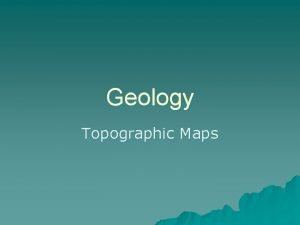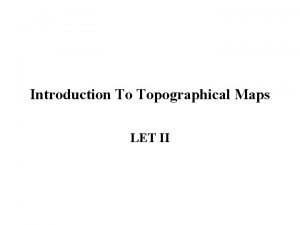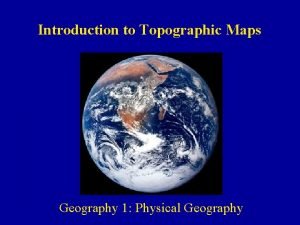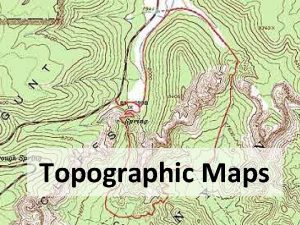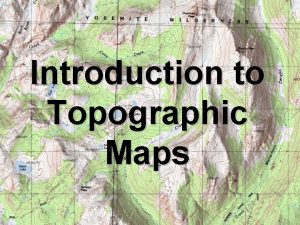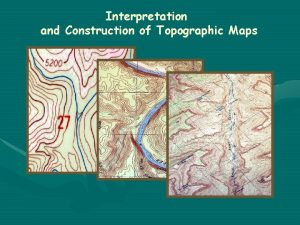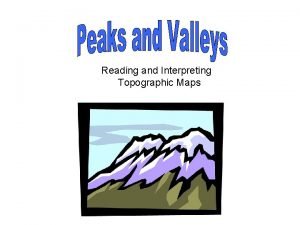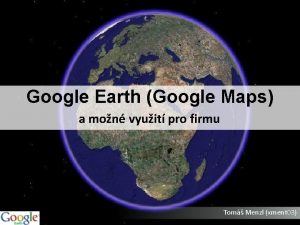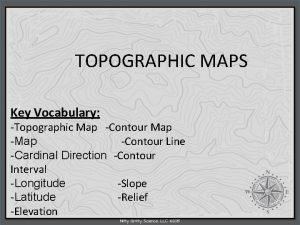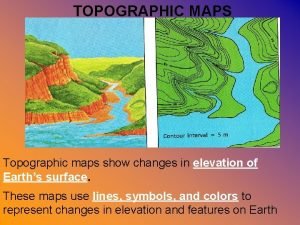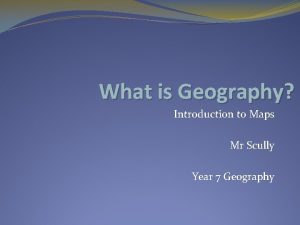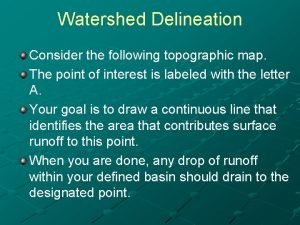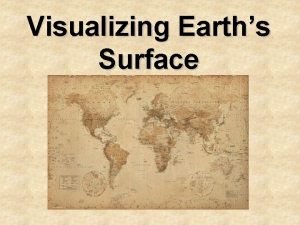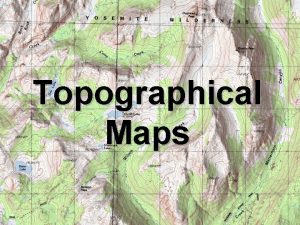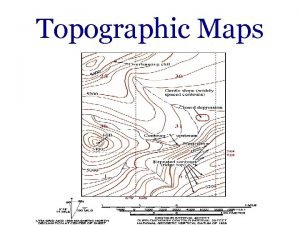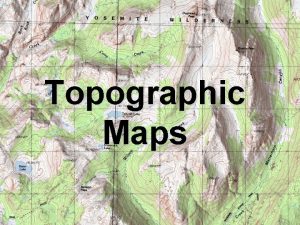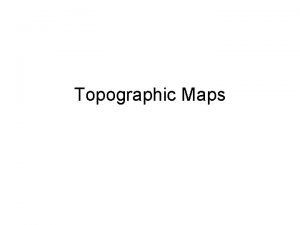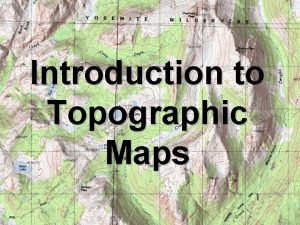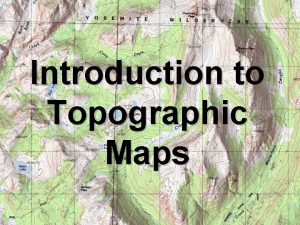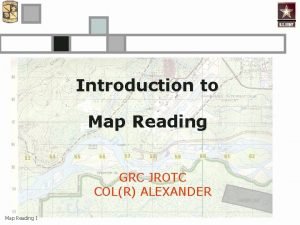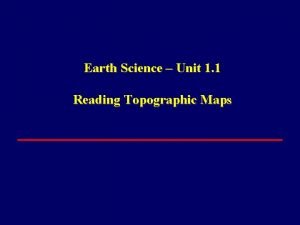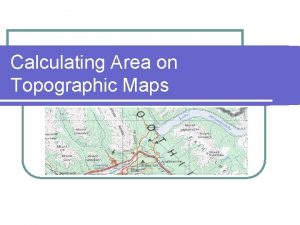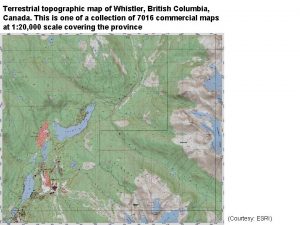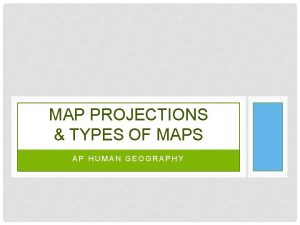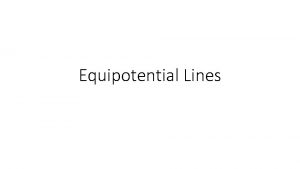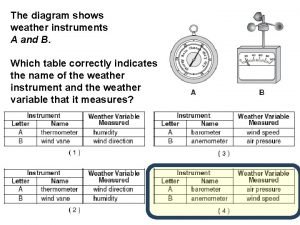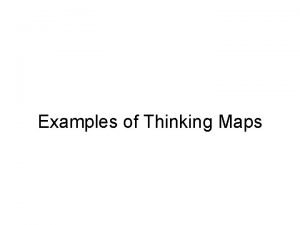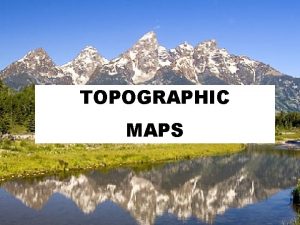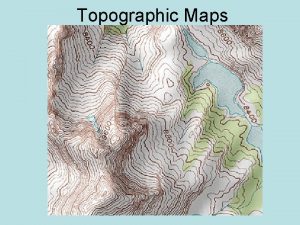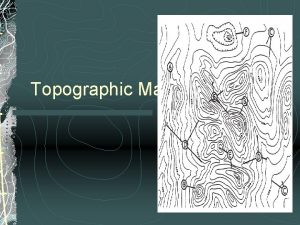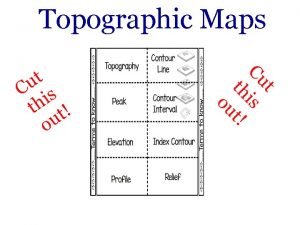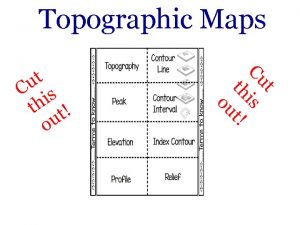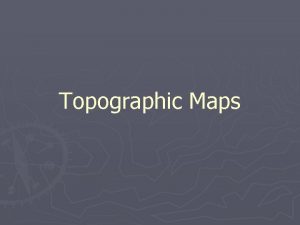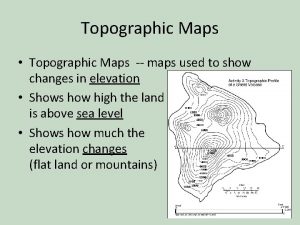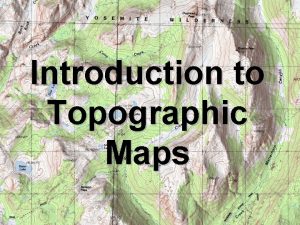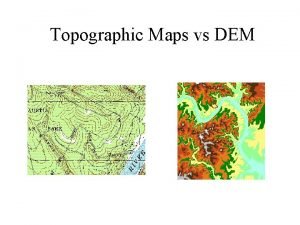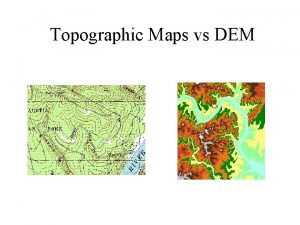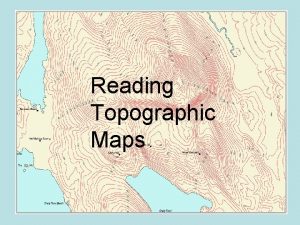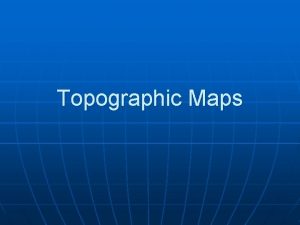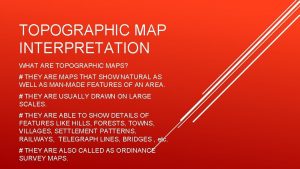Topographic Maps A map that shows the surface
















































- Slides: 48


Topographic Maps • A map that shows the surface features of Earth • Shows the e. LEv. ATion of an area –Height of an object above sea level


Topographic Map Features • Natural Features –Rivers, lakes –Mountains • Artificial (man made) features –Cities –Roads, bridges


Parts of a Topographic Map 1. Contour Lines • A line that connects points of equal elevation • Used to show features of the land • Spacing of lines depends on slope of land – Close lines = steeper slope – Farther apart = gentle slope




Parts of a Topographic Map 2. Contour Interval The difference in elevation between one contour line to the next • Stays the same throughout a map


Parts of a Topographic Map 3. Index Contour • A darker, bolder contour line that indicates a change in elevation • Usually found every fifth (5 th) contour line


Reading Topographic Maps • Features on Earth’s surface can be represented by colors –Blue = Water –Brown = contour lines –Green = wooded areas

Golden Rules of Topographic Maps 1. Contour lines never cross, all points on a line represent one elevation 2. Spacing of contour lines depends on steepness of slope 3. Tops of mountains or hills are shown by closed circles

Golden Rules of Topographic Maps (continued) 4. Contour lines that cross a valley or stream are V-shaped –The V points towards the area of highest elevation 5. Depressions have hash marks pointing towards the center



Let’s take a walk up a hill!

We’re now at an elevation of 100 meters. 100 m

Let’s keep going! 100 m

Now we’re at 200 m 100 m

Shall we march on? 200 m 100 m

We’ve made it to 300 m! 300 m 200 m 100 m

On to the peak! 300 m 200 m 100 m

We’re on the peak, but what’s our elevation? 300 m 200 m 100 m

Any ideas? Let’s add contour lines for every 50 meters and see if that helps. 300 m 200 m 100 m

We know that we are above 350 m, but less than 400 m. 350 m 300 m 250 m 200 m 150 m 100 m 50 m

Let’s head down the hill, it’s getting late! 350 m 300 m 250 m 200 m 150 m 100 m 50 m

Now what’s our elevation? If you said somewhere between 200 m and 250 m you are right! 350 m 300 m 250 m 200 m 150 m 100 m 50 m

Let’s try this again! 350 m 300 m 250 m 200 m 150 m 100 m 50 m

What’s our elevation now? If you said 50 m or just under, you’re right! 350 m 300 m 250 m 200 m 150 m 100 m 50 m

Let’s now look at the same hill, but the way we might see it from an airplane!

Each color change represents a 50 meter increase.

Now, let’s try the same hike! Our elevation is 0 meters.

Now what is our elevation?

If you said more than 150 meters, but less than 200 meters your right!

Let’s go a little higher.

Think you know our elevation now? More than 300 meters--But less than 350 meters

If we were standing on the peak, what would be our elevation? More than 350 meters, less than 400 meters

Let’s head down hill.

Know our elevation?

More than 100 meters, less than 150 meters


Grab a piece of paper and write your answers to the following questions. Ready?

1. Could the elevation at the peak (B) be 1410 meters? 2. What is the elevation at (E)? 3. What is the elevation difference between (A) & (B)? 4. Could the elevation at (F) be 417 meters? 5. If you walked a straight line from (D) to (C) would you walk over a ridge or down a valley? 6. Just looking at the map, would it be easier to head down from the peak going East, or going North?

E C D B 1200 m F 1000 m A 400 800 m m 600 m

1. No : The elevation must be under 1400 meters, but over 1300 meters. 2. about 400 meters 3. (A) is probably close to the 750 meter line, (B) is above 1300 meters. The difference between the two would probably be 650 to 700 meters. 4. No: It must be more than 700 meters and less than 800 meters. 5. Down a valley: If the contour lines point up the slope it’s a valley, if they point down the slope it’s a ridge. 6. East: When contour lines are close together that means there is a steep slope, the further apart the lines, the more gentile the slope and therefore an easier walk! Go east!
 Whats contour interval
Whats contour interval Introduction to topographic maps
Introduction to topographic maps Topographic map of bangladesh
Topographic map of bangladesh What are index contour lines on a topographic map
What are index contour lines on a topographic map Gradient contour lines
Gradient contour lines Topographic map construction
Topographic map construction Vertical interval of a map
Vertical interval of a map Topographic maps show
Topographic maps show Topographic map vocabulary
Topographic map vocabulary Topographic map
Topographic map Independent practice: topographic maps
Independent practice: topographic maps A map that shows changes in elevation of earth's surface
A map that shows changes in elevation of earth's surface Phân độ lown ngoại tâm thu
Phân độ lown ngoại tâm thu Block nhĩ thất độ 2 mobitz 1
Block nhĩ thất độ 2 mobitz 1 Thơ thất ngôn tứ tuyệt đường luật
Thơ thất ngôn tứ tuyệt đường luật Thơ thất ngôn tứ tuyệt đường luật
Thơ thất ngôn tứ tuyệt đường luật Chiến lược kinh doanh quốc tế của walmart
Chiến lược kinh doanh quốc tế của walmart Tìm độ lớn thật của tam giác abc
Tìm độ lớn thật của tam giác abc Con hãy đưa tay khi thấy người vấp ngã
Con hãy đưa tay khi thấy người vấp ngã Tôn thất thuyết là ai
Tôn thất thuyết là ai Gây tê cơ vuông thắt lưng
Gây tê cơ vuông thắt lưng Sau thất bại ở hồ điển triệt
Sau thất bại ở hồ điển triệt Maps google maps reittihaku autolla
Maps google maps reittihaku autolla Geography lines
Geography lines Watershed delineation
Watershed delineation Hachured contour lines on a topographic map represent
Hachured contour lines on a topographic map represent A topographic map is a two dimensional model
A topographic map is a two dimensional model Whats a topographic map
Whats a topographic map A topographic map is a two dimensional model
A topographic map is a two dimensional model Contour index lines
Contour index lines A topographic map is a two dimensional model
A topographic map is a two dimensional model A topographic map is a two dimensional model
A topographic map is a two dimensional model Hill valley ridge saddle depression
Hill valley ridge saddle depression Glen samaai
Glen samaai Topographic map def
Topographic map def How to calculate map
How to calculate map Remote sensing ap hug
Remote sensing ap hug Whistler topographic map
Whistler topographic map Orienteering compass
Orienteering compass Hachured contour lines definition
Hachured contour lines definition Human geography types of maps
Human geography types of maps What is the elevation of point b?
What is the elevation of point b? Topographic map cliff
Topographic map cliff Graduated symbol map definition ap human geography
Graduated symbol map definition ap human geography When god shows up he shows off
When god shows up he shows off Which diagram shows surface weather measurements?
Which diagram shows surface weather measurements? Mercury's surface most resembles which of these
Mercury's surface most resembles which of these Tree map thinking process
Tree map thinking process Example of brace map
Example of brace map
